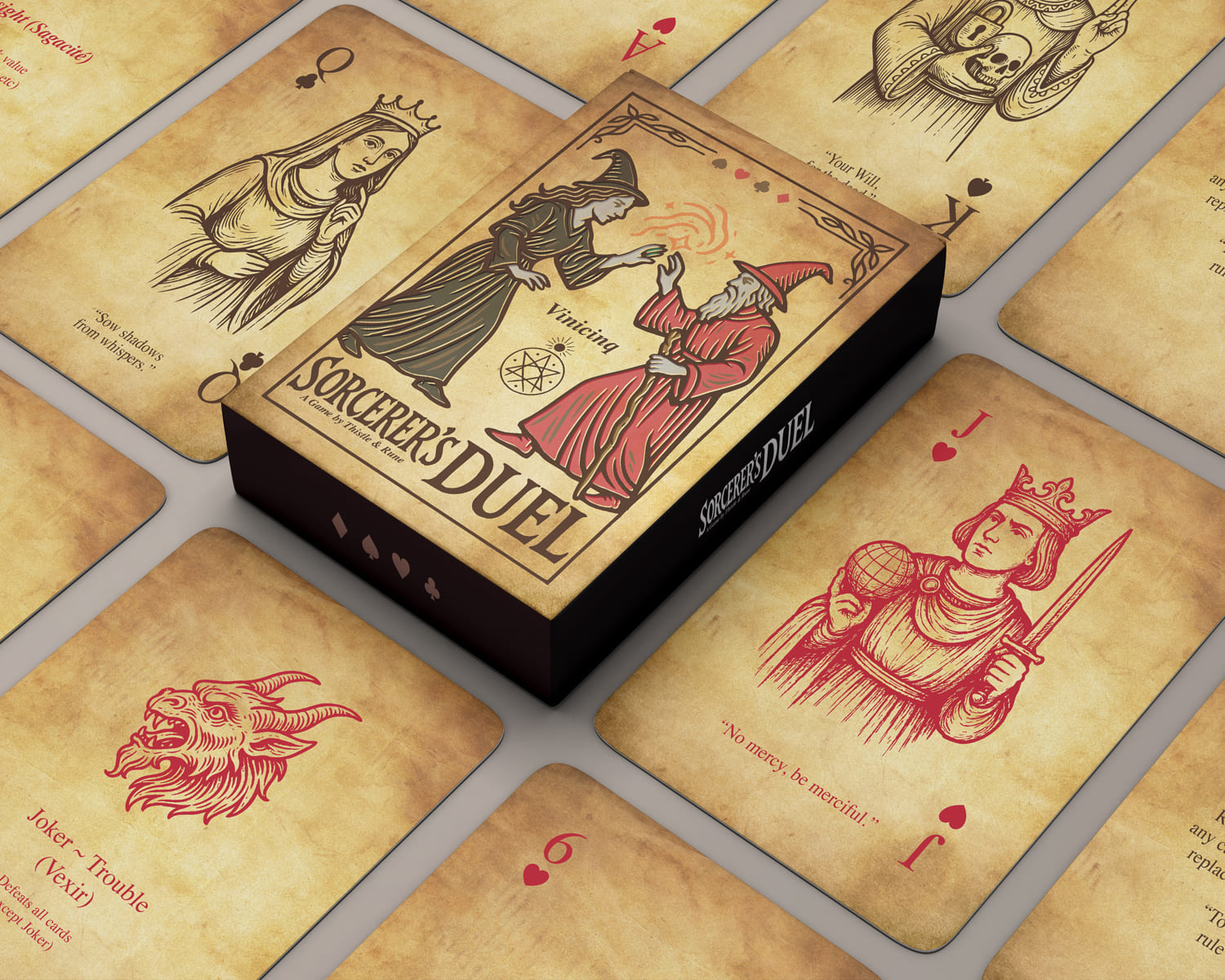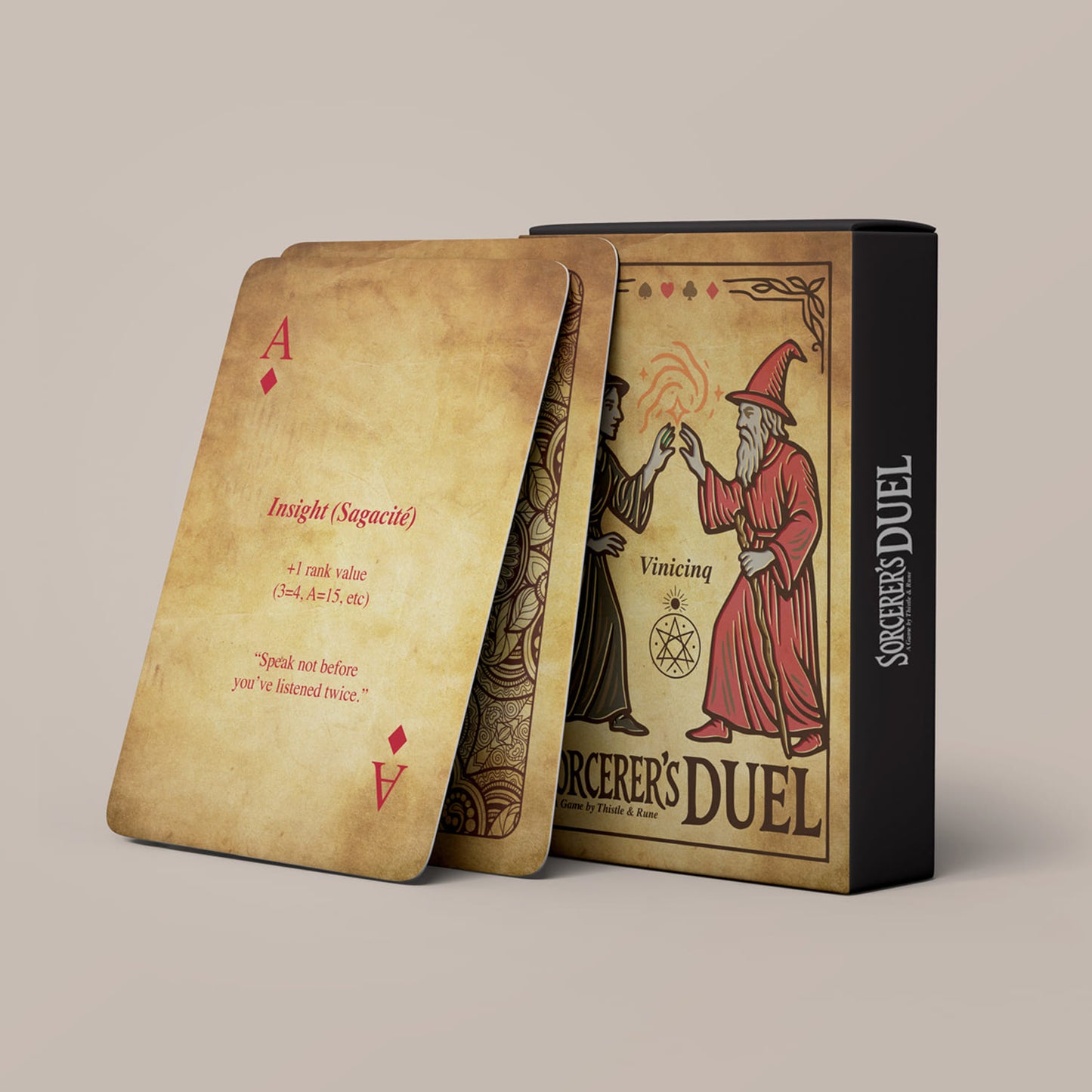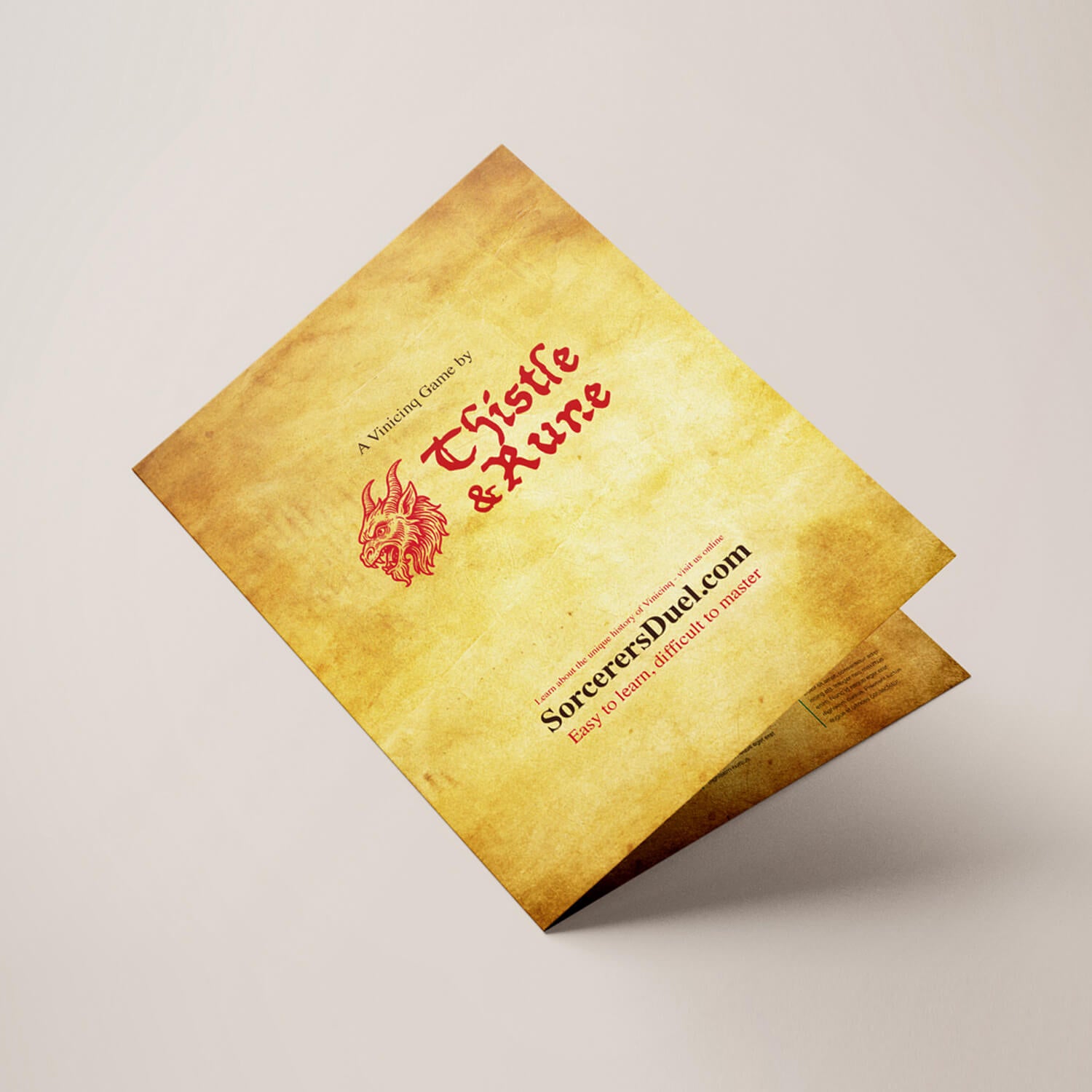
Sorcerers' Duel – A Battle of Arcane Might
HISTORY
Vinicinq: Discovered in Silence. Played in Secrets.
Origins
Originally known as Vinicinq, this game is believed to have emerged in early medieval France, circa 1130–1170. The name itself has sparked debate among scholars—some propose it derives from vin (wine) and cinq (five), perhaps alluding to the original number of cards used or hinting at clandestine gatherings among the nobility.
Accounts, though sparse and largely based on oral tradition, suggest that Vinicinq was more than mere entertainment. It is said to have been adopted as an educational tool for the young nobility, teaching the finer arts of negotiation and the covert arts. With its simple rules that belie a deeper strategic complexity, the game embodied the principle of being "easy to learn, hard to master." Its accessible mechanics allowed even novice heirs to grasp the basics quickly, while its layered subtleties offered endless challenges for those who sought to excel in diplomacy and strategy.
Some narratives link the game’s creation to the turbulent aftermath of a royal murder during the reign of King Louis VI, while others hint at secretive intrigues at the court of King Philip II. In these accounts, Vinicinq was reputedly used as a discreet medium for passing hidden messages and honing skills in persuasion and subterfuge.
As the centuries passed, the game’s arcane symbols and reputed associations with forbidden lore aroused suspicion. Vague records indicate that during the period of the Albigensian Crusade and the subsequent inquisitorial measures (circa 1209–1229), Vinicinq was banned for its alleged heretical elements—its mysterious nature seen as a threat to the established religious order.
In modern times, the game has been rebranded as Sorcerer’s Duel, yet it retains the enigmatic legacy of its past. Its evolution from Vinicinq reflects a rich tapestry of medieval intrigue, education, and covert strategy—an enduring tradition that continues to captivate those who appreciate both its historical mystique and its challenging depth.
Meet Étienne
Étienne Rougemont was a reclusive French antiquarian, mystic scholar, and former professor of comparative symbology at the Université de Strasbourg. Born in 1866 in Lyon to a family of minor nobility, Rougemont devoted his life to the obscure and the arcane. Though respected in certain academic circles, he was known more broadly for his eccentric theories regarding pre-Christian European mystery cults and forgotten games of ritual significance, both of which were popular topics of the time.
In 1923, while researching medieval ecclesiastical markings in the ruins of an abbey outside Chartres, Rougemont discovered a hidden crypt beneath a collapsed sacristy. There, sealed in a lead-bound box and protected by a layer of beeswax, he unearthed what he claimed to be an original deck and rule codex of a game long thought myth: Vinicinq.
Vinicinq, mentioned only obliquely in Gnostic heresies, Troubadour poetry, and scattered footnotes of early Vatican correspondence, was rumored to be a symbolic card game played by wandering mystics and royalty alike—part strategy, part ritual, part parable, part education. Its rules were fragmentary at best—until Rougemont's discovery. The sparse fragments of lore surrounding the game included references to coded messages within the cards as well as a covert way for royalty at the time to share secrets, insight and directions undetected. The original game Vinicinq served as both a form of entertainment and a method for teaching royal youth the intricacies of court life, strategies for ruling successfully and the importance of wisdom, action and war.
Obsessed with the game, Rougemont began cataloging, restoring, and attempting to reconstruct Vinicinq’s complex metaphysical structure. He gave a single public lecture on it in Paris in 1926, which was sparsely attended and dismissed as esoteric nonsense. That same year, political tensions in Europe began to rise—and by the outbreak of World War II, Rougemont's private collection, including the last remaining Vinicinq deck and original descriptive manuscript, was declared “a risk” by Nazi occultists.
Fleeing through the Alps with only a satchel, Rougemont made his way into the remote Swiss mountains, where he lived the rest of his long life in quiet isolation.
He died in 1977, aged 111, and was buried in an unmarked grave.
His collection vanished. Until now...
My Store
Sorcerer’s Duel: Core Deck
Share

RULES
Sorcerer's Duel

Round Structure
- Each player selects one card from their hand and places it face down.
- Both cards are revealed simultaneously.
Apply Suit Effects
- Comparison: Compare the modified card values, including any suit bonuses.
- The higher-value card wins the round and captures both played cards.
Tie Situation
- both cards are equal in value and no suit effect breaks the tie, the round is a draw.
- In a draw, both cards are discarded.Hearts automatically win ties.
Post-Round Actions
- Resolve any lingering suit effects (e.g., Spade discard effect).
- Both players draw cards until they have 5 cards in hand (if available).
Game End & Final Scoring
End of Game:
- The game ends when either player has no cards left in both their hand and deck.
Scoring:
- Number cards (2–10): 1 point
- Face cards (J, Q, K, A): 2 points
- Jokers: 0 points
- If one player has cards remaining after the other is empty, they may score the remaining cards in their hand and deck.
Winner:
- The player with the highest score wins.
Tie-Breaker:
- If scores are tied, each player shuffles their captured cards and draws one card.
- The higher card wins the game.
- Repeat if necessary.

Deck Setup
- Divide a standard 52-card deck evenly: each player receives 26 cards.
- (Optional) Each player may include one Joker.
- Shuffle decks separately and set aside for drawing.
- Each player draws 5 cards to form their starting hand.
Card Rankings
- Ace = 14
- King = 13
- Queen = 12
- Jack = 11
- Number cards (10–2) = Face value
Suit Abilities
The club card has been updated. Please see the current errata rule below.
- ♥ Hearts (Force): Automatically win ties.
- ♦ Diamonds (Insight): Count as +1 rank (e.g., 3 = 4, Ace = 15).
- ♠ Spades (Fear): If you win with a Spade, your opponent discards a random card from hand.
- (current rule) ♣ Clubs (Illusions): After reveal, if the Club is lower, you may exchange it with a card from your hand face down. Discard the Club. Resolve normally.
- (old rule) ♣ Clubs (Illusions): After revealing you may exchange for any card in your hand face down, then reveal. note: the old rule was printed on the beta test cards
Joker (Vexir) Effects
- Automatically win the round, unless both players play a Joker.
Clash of Troubles (both Jokers played):
- Both Jokers are discarded.
- Each player shuffles their remaining hand into their deck.
- Both draw 5 new cards.
Additional Rules
- Players may not hold more than 5 cards in hand at any time.
about
Vinicinq: A Game of Secrets, Symbols, and Silent Power
Vinicinq is a game of secrets, symbols, and strategy — a ritual of hidden knowledge played beneath cathedral ruins and whispered through royal courts. Combining simple rules with layered depth, Vinicinq invites players to engage in a contest of wits, bluffing, and timing.
Each round is a silent wager. Each card carries a story. Every suit holds power.
Inspired by fragmented manuscripts and folklore, Vinicinq is more than a game — it’s a restoration of forgotten logic, a mirror of courtly intrigue, and a meditation on lies, insight, fear, and action.
